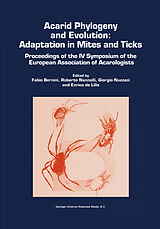Acarid Phylogeny and Evolution: Adaptation in Mites and Ticks
Einband:
Fester Einband
EAN:
9781402004650
Untertitel:
Proceedings of the IV Symposium of the European Association of Acarologists
Genre:
Biologie
Herausgeber:
Springer
Auflage:
2002 edition
Anzahl Seiten:
451
Erscheinungsdatum:
28.02.2002
ISBN:
978-1-4020-0465-0
The words pronounced by Serge Kreiter during the meeting come to mind. They could record exactly the situation of Acarology in Europe and in the World: "I think that in many European countries there are very few full time acarologists. It is very rare to have new positions available . . . . And public money, from the European Community but also from national countries, is very hard to get when you want to work on mites . . . . Could two acarological associations in Europe (Eur. A. Ac. and S. I. A. L. F) work together or, better, get married?" So, the fourth symposium of the European Acarologists has not only been the occasion to have an idea on which direction the research is addressed today, but also it pointed out the difficulties of our "scientific hranch". On the basis of the presentations and invited papers we had evidences of a "new" Acarology based on modern techniques and methods of investigations but also the importance, often sheltered even if of relevant value, of the "old" Acarology made on the alpha taxonomy and basic studies. So, a "new" Acarology needs the "old" one. In this context, the hope to put together the European acarologists has been coming up. This fact, of political meaning, can surely improve the acarological movement and the discussion on this point showed clearly the importance of several other activities and efforts in this direction. We hope that the meeting in Siena will represent a significative stone for the progress of Acarology.
Inhalt
Preface. Presidential address; F. Bernini. As time goes by: a profile of Italian Acarology; S. Ragusa. Phylogeny, Genetics and Speciation. Mites as models in development and genetics; R.H. Thomas. Speciation and biogeography in eriophyid mites: a review; B. Fenton. Mitochondrial DNA variation and phylogeography of Steganacarus on Tenerife (Canary Islands); N. Salomone, F. Bernini. Preliminary report on fossil oribatid mites from the Florisbad Quaternary Research Station, South Africa; L. Coetzee. An Early Ordovician oribatid mite (Acari: Oribatida) from the island of Öland, Sweden; F. Bernini, et al. Genetic Polymorphism in prey preference at a small spatial scale: a case study of soil predatory mites (Hypoaspis aculeifer) and two species of astigmatic mites as prey; I. Lesna, M.W. Sabelis. Experimental hybridization of Rhizoglyphus robini and R. echinopus (Acari: Acaridae). Morphology, Life Strategies and Physiology. Water Inhabiting Mites. The water mites (Acari, Hydrachnidia) of a little disturbed forest stream in southwest Germany - a study on seasonality and habitat preference, with remarks on diversity patterns in different geographical areas; R. Gerecke. The biodiversity of Neotropical water mites; T. Goldschmidt. Life history strategies of Hygrobates nigromaculatus, a widespread palaearctic water mite (Acari, Hydrachnidia, Hygrobatidae); P. Martin, C. Davids. The impact of human activity on the water mite fauna (Acari, Hydrachnidia) of the `Lasy Janowskie' Landscape Park (South-Eastern Poland); R. Stryjecki. The occurrence of water mites (Hydrachnidia, Acari) in saline waters from a stone coal-mine in Bogdanka (South-Eastern Poland); W. Kowalik. Soil Inhabiting Mites. Reproductive systemsof gamasid mites (Acari, Anactinotrichida) reconsidered; G. Alberti.Morphological variability between and within populations of Tectocepheus (Acari, Oribatida, Tectocepheidae) from the velatus-complex in central Europe; G. Weigmann. Endogynium types in Parasitidae as revealed by SEM (Acari: Gamasida: Parasitina); W. Witalinski, K. Borsuk. Colonization of primary sterile soils by epedaphic gamasina mites; A. Christian. Colonization of a dolomitic dump by mesostigmatid mites (Acari, Mesostigmata); G. Madej, P. Skubala. Zoogeographical survey on the Phthiracaroidea (Acari, Oribatida) of the Ethopian region; W. Niedbala. The occurrence of Macrocheles mites (Acari: Macrochelidae) in relation to the activity of dung beetles: a field study in Southern France; H. Glida, M. Bertrand. Development of oribatid mite communities (Acari, Oribatida) on a mine dump; P. Skubala. Parasitic Mites. Three-dimensional structure of the gut system of the mites Ameronothrus lineatus (Oribatida: Ameronothridae) and Hyadesia fusca (Astigmata: Hyadesiidae); J. Bücking. Ultrastructural investigations of Haller's organ in Dermacentor reticulatus (Fabr.) (Acari: Ixodida: Ixodidae); A. Buczek, et al. Morphologic adaptations to parasitism on reptiles: Pterygosomatidae (Prostigmata: Raphignathina); M. Bertrand. Plant Inhabiting Mites. Fine Structure of the phytoseiid-type sperm access system (Acari, Gamasida, Phytoseiidae); G. Alberti, A. Di Palma. Fine morphology of the bothridial receptor organs of Pediculaster mesembrinae (Acari: Siteroptidae) adult female; E. de Lillo, P. Aldini. Fine structure of a putative pedipalpal thermo/hygrosensillum in Tarsonemus nodosus Schaarschmidt, 1959 (Acari: Tarsonemidae); G. Nuzzaci, et al.

Leider konnten wir für diesen Artikel keine Preise ermitteln ...
billigbuch.ch sucht jetzt für Sie die besten Angebote ...
Die aktuellen Verkaufspreise von 6 Onlineshops werden in Realtime abgefragt.
Sie können das gewünschte Produkt anschliessend direkt beim Anbieter Ihrer Wahl bestellen.
Loading...
Die aktuellen Verkaufspreise von 6 Onlineshops werden in Realtime abgefragt.
Sie können das gewünschte Produkt anschliessend direkt beim Anbieter Ihrer Wahl bestellen.
| # | Onlineshop | Preis CHF | Versand CHF | Total CHF | ||
|---|---|---|---|---|---|---|
| 1 | Seller | 0.00 | 0.00 | 0.00 |
